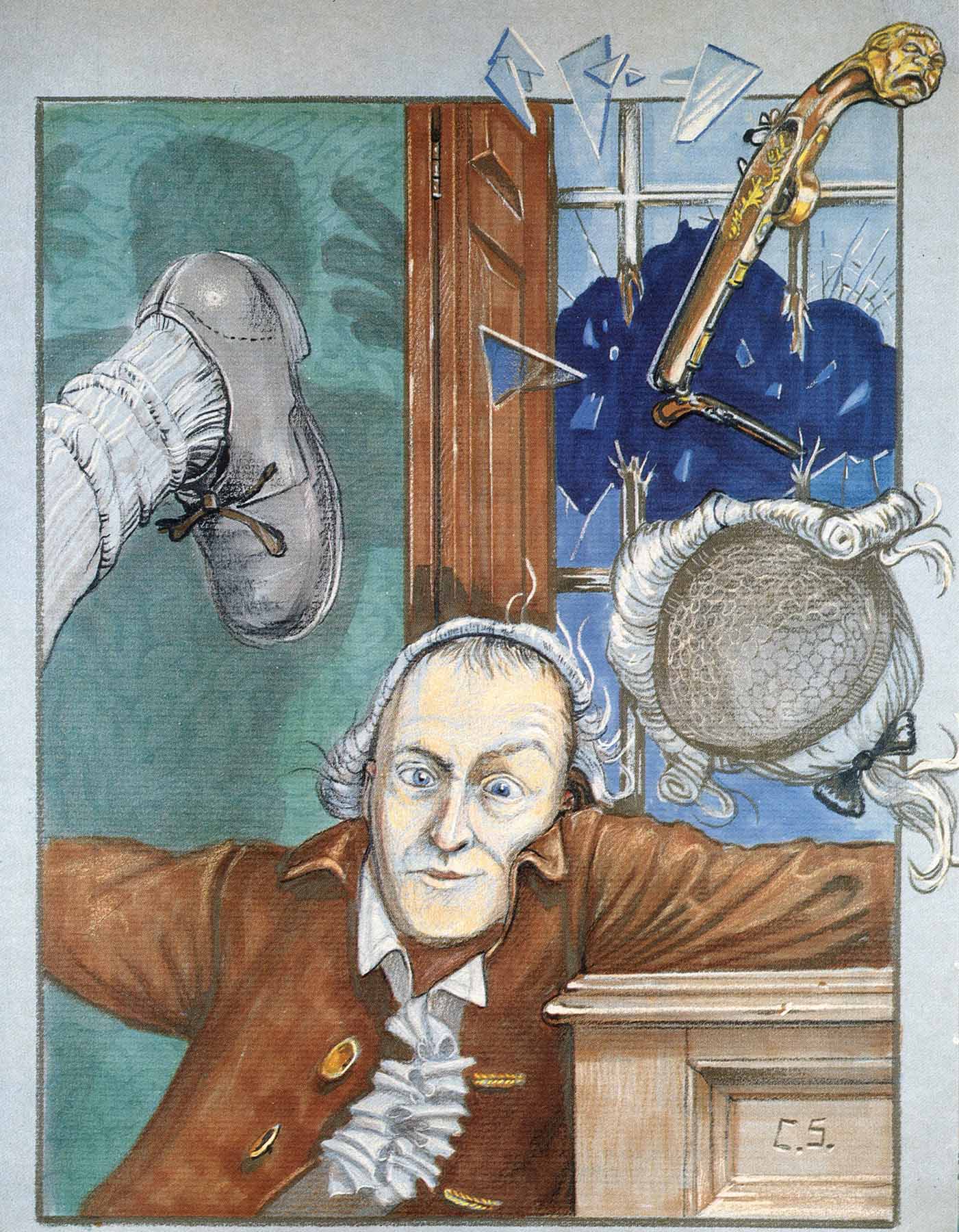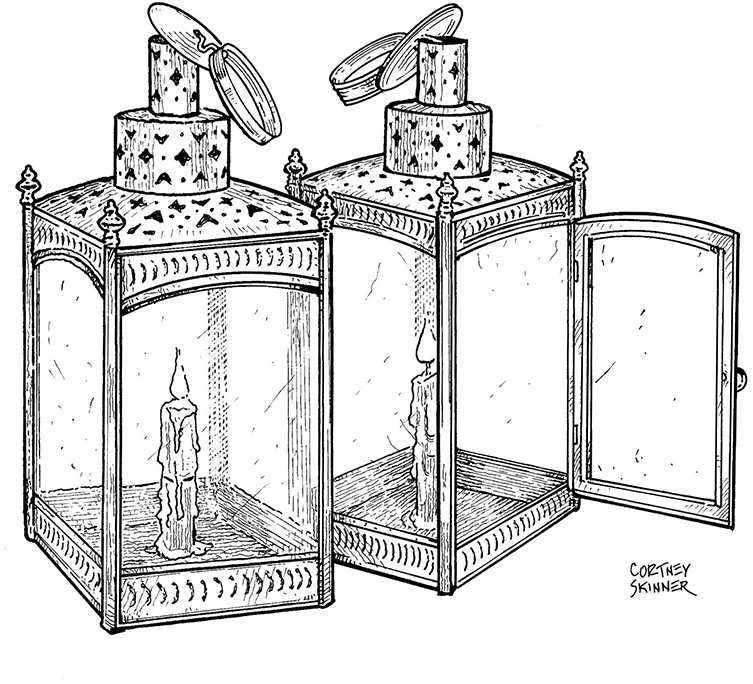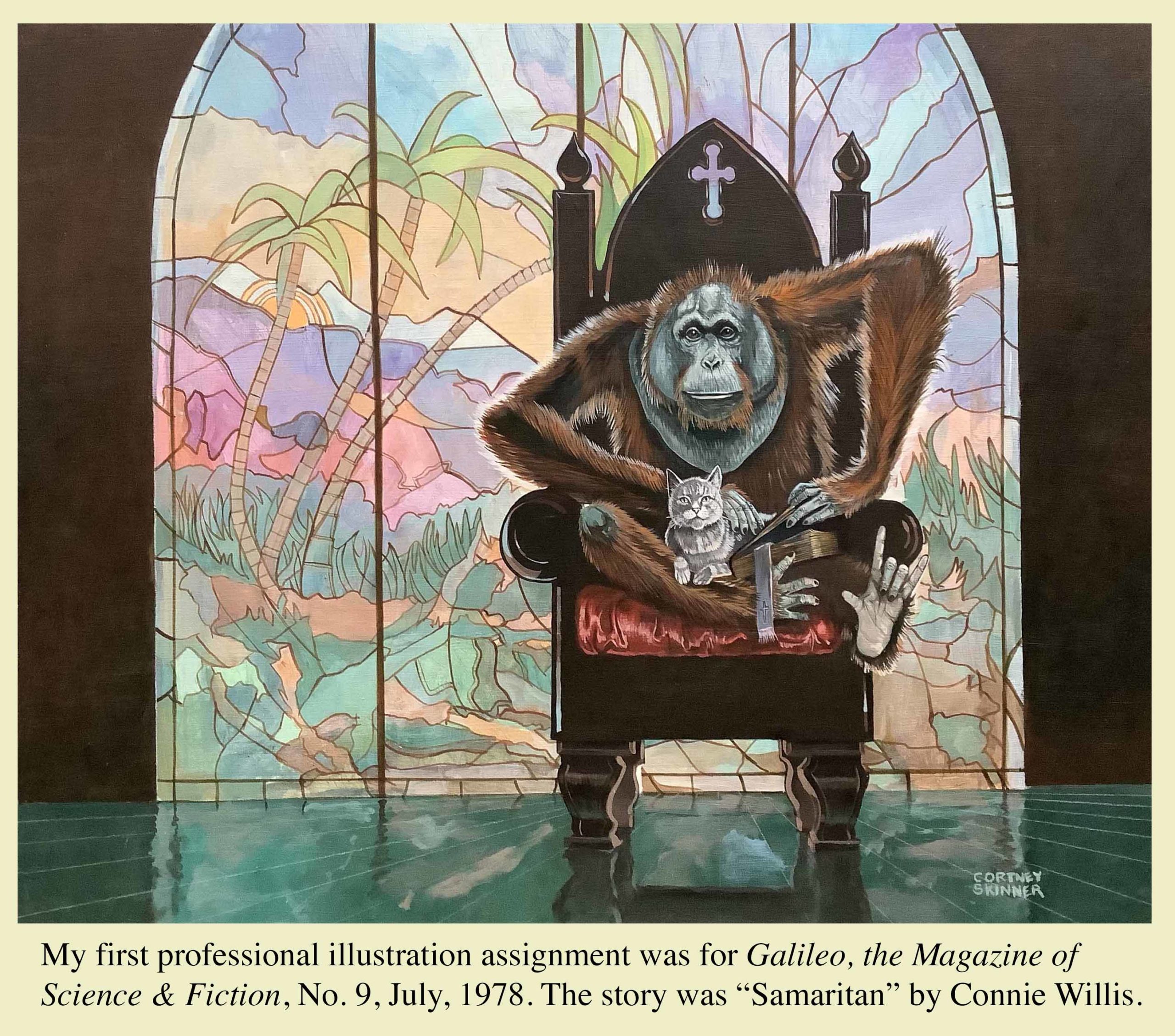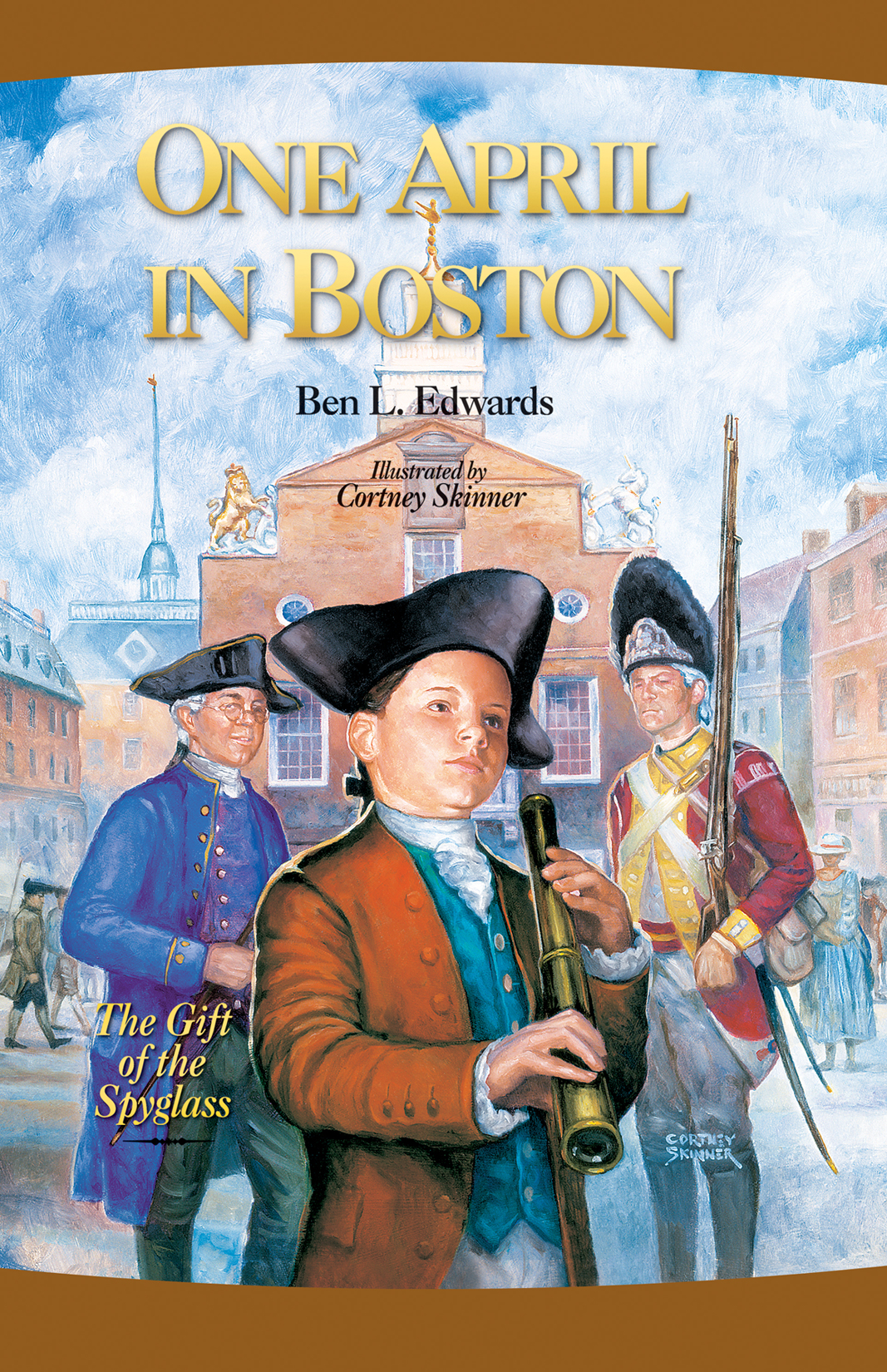One April in Boston
My Journey—Student to Working Illustrator
A career with twists and turns that always circled back to a fascination with and a love for history
by Cortney Skinner | 01.06.20
Completing the illustration course at the Art Institute of Boston did not endow me with a degree of any kind, but it did give me the basics in commercial art production. Looking about for work where those basics might be employed, I found a job offer from a very small Boston advertising agency. When I was given a tour by the boss, I was more than a bit dismayed to see a long, dark, narrow room with an aisle dividing two rows of drawing boards with about a dozen Bob Cratchits bent over their work silently scratching with their pens at their assignments, their hands kept from freezing by fingerless gloves, and the room’s dank chill kept at bay by ragged scarfs wrapped around their necks.
Well, maybe that’s a bit of an exaggeration. However, if you recall the Roman galley scene from Ben Hur, then that’ll zero in on how I felt about this first commercial art employment offer. Needless to say, I wasn’t keen on being chained to a drawing board. So—although I was supposed to begin the following Monday—I did not go back.
As with most fledgling artists and illustrators fresh out of art school, I took on various part- and full- time jobs to support myself while I worked on my painting and drawing skills in my spare time. Science fiction was an interest of mine. There were a number of local New England science fiction conventions, so I entered their art shows, selling a few pieces now and then. Pen and ink and acrylic paints were my mediums of choice. Acrylic paints dried rapidly and allowed instant overpainting of layers. This was important for being able to adjust and tweak a painting.
In the late 1970s, a part-time job at the Avenue Victor Hugo Bookshop in Boston led to my first regular professional illustration assignment for the science fiction magazine, Galileo, which was published by Vincent McCaffery, the bookstore’s owner and a fine art director. The story was “Samaritan” by Connie Willis and my illustration was painted in acrylic. The story concerned an episode in the future when a church employed an orangutan to clean a valuable stained glass window. The ape’s long arms and brachiating abilities allowed him to do the simple job without using ladders or scaffolding which could endanger the window. Without my synopsis being too much of a spoiler, the orangutan (who had a pet cat) requested that he be baptized, using sign language to make that request. The conundrum for the minister was whether an ape, even though apparently sentient, could be baptized.
The above details about this assignment are mentioned because the most important part of an illustration job is careful interpretation of the scene to be illustrated. This is a skill that can be taught, but it’s also a skill that can and should grow with experience and observation of other artists’ work.
Research can be one of the most interesting parts of the job for illustrators. Maybe research should be called “focused daydreaming,”—casting open the mind to gather as many diverse and numerous images and information of the subjects to be illustrated. What is now done chiefly by Googling was done back then by trips to museums, libraries, archives, and (hopefully) a coffee shop or two for sustenance. It was no easy matter back then to find reference for an orangutan… or, for that matter, any of the elements in that painting. I was lucky to find a neighborhood cat to pose for my reference.
 As was mentioned in my previous blog post, history has always been a fascinating subject for me, and with one of my illustrations for another SF publication, Aboriginal Science Fiction Magazine, I was able to combine my love for history with science fiction. The cover story, “Three if by Norton” by Ralph Roberts, concerned a time-traveler riding a Norton motorcycle carrying a time machine that transported him back to 1775 Boston. This biker then had to take the place of the indisposed patriot Paul Revere on his ride to Lexington. The fun for me was my reference for the painting: posing three uniformed living history enthusiasts who not only came authentically clothed and armed, but also helped to make sure the details were correct for the period. Eric and Dave (as British soldiers) as well as Julia (seen at the top in the window) were wonderful models. I didn’t mind when one of their bayonets on the end of their more-than-five-foot long muskets made a gouge in the living room ceiling as I took the reference photos. I wonder if it’s still there in that Arlington, Massachusetts house—evidence of modern-day British reenactors in a house located only yards away from where the actual British troops had made their bloody retreat after the battles of Lexington and Concord?
As was mentioned in my previous blog post, history has always been a fascinating subject for me, and with one of my illustrations for another SF publication, Aboriginal Science Fiction Magazine, I was able to combine my love for history with science fiction. The cover story, “Three if by Norton” by Ralph Roberts, concerned a time-traveler riding a Norton motorcycle carrying a time machine that transported him back to 1775 Boston. This biker then had to take the place of the indisposed patriot Paul Revere on his ride to Lexington. The fun for me was my reference for the painting: posing three uniformed living history enthusiasts who not only came authentically clothed and armed, but also helped to make sure the details were correct for the period. Eric and Dave (as British soldiers) as well as Julia (seen at the top in the window) were wonderful models. I didn’t mind when one of their bayonets on the end of their more-than-five-foot long muskets made a gouge in the living room ceiling as I took the reference photos. I wonder if it’s still there in that Arlington, Massachusetts house—evidence of modern-day British reenactors in a house located only yards away from where the actual British troops had made their bloody retreat after the battles of Lexington and Concord?
 For the second illustration for that story, my research took me up to the actual historic house where Revere culminated his mission: the Hancock-Clarke House in Lexington. I researched the rooms, the wallpaper, and the furnishings where a climactic scene in this wacky science-fiction story took place. Though a comic and quirky tale, I wanted the illustrations to be informed by accurate historical research. In this tale of science-fictional skewed history, John Hancock is launched across the room, wigs and flintlock pistols flying. All these items were researched and illustrated as accurately as possible even though the story was more unhinged than historical.
For the second illustration for that story, my research took me up to the actual historic house where Revere culminated his mission: the Hancock-Clarke House in Lexington. I researched the rooms, the wallpaper, and the furnishings where a climactic scene in this wacky science-fiction story took place. Though a comic and quirky tale, I wanted the illustrations to be informed by accurate historical research. In this tale of science-fictional skewed history, John Hancock is launched across the room, wigs and flintlock pistols flying. All these items were researched and illustrated as accurately as possible even though the story was more unhinged than historical.
Little did I know that, decades later, after my move to Virginia, I’d be working with author Ben Edwards in researching and painting some of the same locales, buildings and details for his book One April in Boston and ensuing historical projects. In successful historical illustration, research is a collaborative enterprise, especially if the illustrator lives far from where the documented sources for the illustrations reside. Ben’s intimate familiarity with the history and landmarks of the greater Boston area and his connections to historic sites have been invaluable resources for my research of the Revolutionary period.
Since the bayonetted ceiling episode, my interest in history illustration has grown exponentially, and though I have enjoyed illustrating all manner of science-fiction subjects, hobbits, monsters, Star Wars characters, educational books, and a few jobs for films, historical subjects seem to resonate the most for me. My fortuitous meeting with Ben in 1998 at the Paul Revere House in Boston and his One April in Boston book allowed me to hone my pen and ink skills in historical illustration. The recent commission of a series illustrating Paul Revere’s ride made it possible for me to strengthen my skills using digital paint but in a traditional, painterly style. More about those methods in a later blog post.
Though the mediums and materials for creating historical illustrations have changed drastically over the past decades, the approach has always been the same: to make an historically accurate and hopefully interesting and compelling picture.
Buy the Book Here
Direct from the Author
Paul Revere House - Boston
About This Blog
The Spyglass Blog was created to mark the 20th anniversary of the children’s book One April in Boston. Here the author and illustrator share the stories behind the illustrations, give insight into the artistic process, and introduce related artwork Ben Edwards shares on his Walking Boston private tour. SpyglassBlog.com
Subscribe
Receive notice by email when a new post has been added to the Spyglass Blog.
Meet the Author
Boston’s only private guided walking tour with a children’s book author and relative of Paul Revere. Details below.
Family Tours
Three private tour options. A fun and educational tour of the Freedom Trail your children will love! BostonFamilyTour.com
Field Trips
Field trips for the 2019-2020 school year are Sold Out. Booking now for the fall of 2020. BostonFieldTrip.com
Homeschool Groups
A unique field trip for homeschoolers that teaches your children American history and inspires them to create goals. Homeschool-FieldTrip.com



